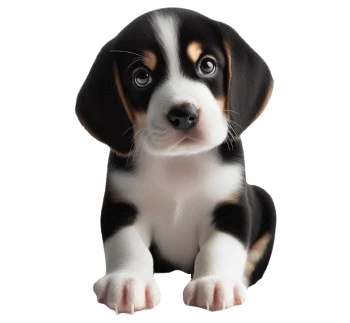
The Small Swiss Hound is a versatile hunting dog from Switzerland, primarily used for hare hunting. It is valued for its excellent sense of smell, persistence, and ability to work in challenging terrain. There are four main varieties, each corresponding to a specific coat color: the Bernese Hound, the Jura Hound, the Lucerne Hound, and the Schwyz Hound.
The Small Swiss Hound is a medium-sized, elegant, and well-proportioned dog. It stands between 33 and 41 cm at the withers and weighs between 8 and 15 kg, depending on the individual. It has a fine head, a slightly elongated muzzle, and long, drooping ears typical of scent hounds. Its expression is gentle and attentive, reflecting its docile nature.
The coat of the Small Swiss Hound varies depending on the variety. It can be short, dense, and smooth, like in the Bernese and Schwyz Hounds, or slightly rougher in the Jura Hound. Coat colors also differ: white and black with tan markings for the Bernese, white with black and reddish patches for the Lucerne, and fawn with a black saddle for the Jura.
This dog stands between 33 and 41 cm at the withers. Males and females are similar in size, with an average weight ranging from 8 to 15 kg. Its compact and muscular build makes it an excellent hunting dog, capable of enduring long distances.
The Small Swiss Hound is known for its balanced, calm, and affectionate temperament. It is gentle with children and gets along well with other dogs. As a hunting dog, it shows great determination in the field and has an exceptional sense of smell. At home, it is rather calm and enjoys spending time with its family. Training should be firm but kind, as it can be slightly independent.
This breed is generally robust but can be prone to certain hereditary conditions such as hip dysplasia and ear infections due to its long ears. Regular ear cleaning and preventive veterinary care are essential to ensure its long-term health.

The Swiss Small Hound Puppy is a medium-sized dog from Switzerland, renowned for its agility and hunting skills. This lively and intelligent dog is primarily used for hunting small game but also adapts well to family life thanks to its affectionate nature. With a strong hunting instinct, it requires consistent and firm training as well as early socialization. Energetic, this puppy needs regular physical activity to stay balanced. It is particularly suited to active families or owners with outdoor space where it can exercise.
The price of a Swiss Small Hound Puppy varies depending on the breeder and lineage. On average, a budget of approximately 1,000 euros is required.
The Small Swiss Hound is a Swiss hunting dog breed, appreciated for its energy, intelligence, and friendly temperament. Training a Small Swiss Hound requires patience, consistency, and an understanding of its specific needs. Here are some tips for successfully training your Small Swiss Hound.
Early Socialization: Socialization is essential for the Small Swiss Hound. Expose your puppy to various environments, people, and animals from an early age. This will help it become a balanced and sociable dog, reducing the risk of aggressive or fearful behaviors.
Positive Reinforcement: Use positive reinforcement methods to encourage good behaviors. Rewards such as treats, toys, or verbal praise are very effective. Avoid harsh punishments that can harm the trust relationship between you and your dog.
Regular Physical Exercise: The Small Swiss Hound is an active breed that needs plenty of physical exercise to stay healthy. Daily walks, search games, and hunting activities are essential for maintaining its physical and mental well-being.
Learning Basic Commands: Teach basic commands like "sit", "lie down", "stay", and "come" as soon as possible. These commands are fundamental for your dog's safety and control in various situations.
Mental Stimulation: In addition to physical exercise, provide your Small Swiss Hound with activities that stimulate its mind. Puzzle games and training sessions can help keep it mentally active and avoid boredom.
Consistency and Patience: Be consistent in your rules and expectations. All family members should follow the same guidelines to avoid confusing the dog. Patience is also crucial, as learning can take time.